The silk road is the name given to a vast interregional trade network that primarily saw silk moving west from China, with precious metals moving in the opposite direction. The effects of this trade are visible in various ways in different places. Here in Uzbekistan, the wealth accumulated through trade facilitated the building of opulent cities in a region that was otherwise populated primarily by nomadic groups.
Khiva is an example of such a city. Founded about 1500 years ago, it was for centuries a small trading town, growing to a larger city when it became capital of Khwarezm. Besides silk, Khiva had a reputation in slave trading that lasted for centuries. The resources acquired through such trade produced many monuments. I set out early in the morning from the hostel to explore. There has been a lot of restoration work done during the Soviet period but it was done in quite an unobtrusive fashion.
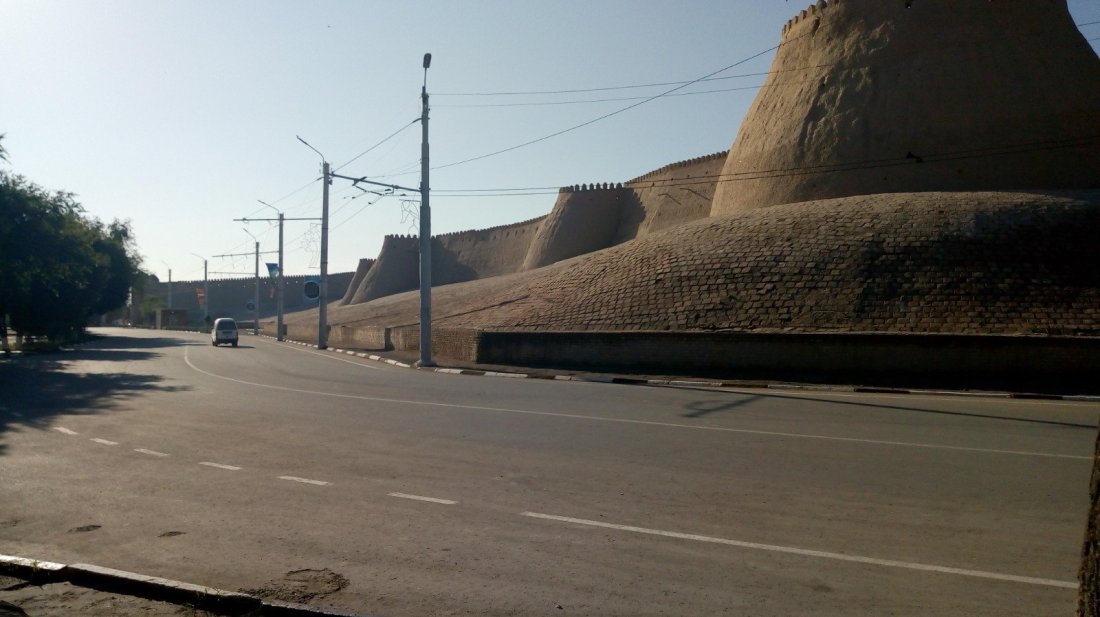

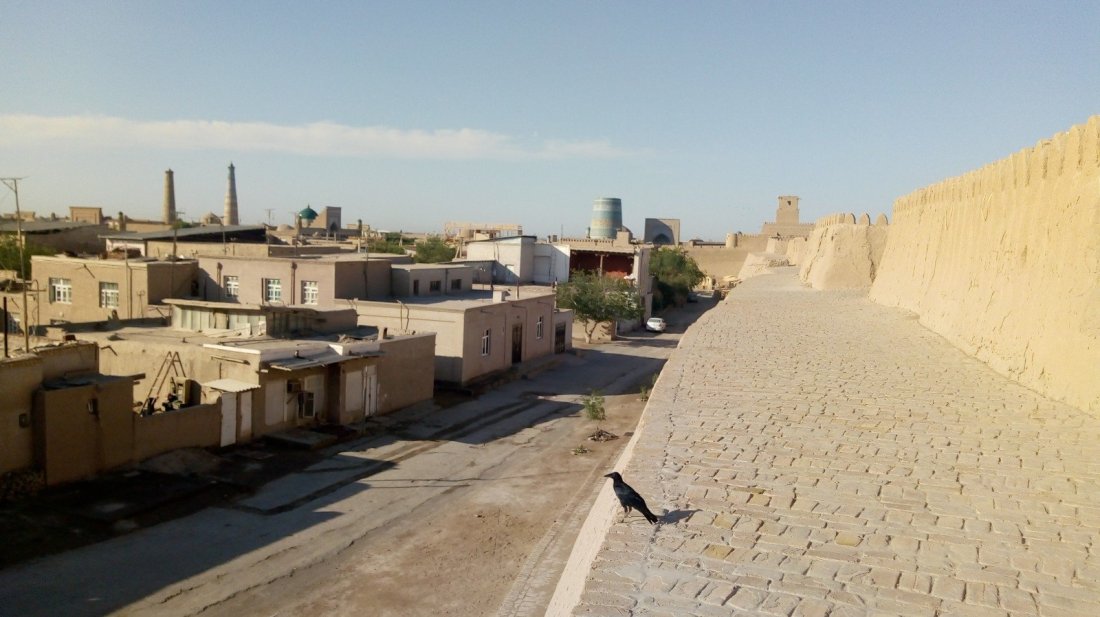





he heat in the middle of the day was quite unpleasant so I headed back to the hostel to relax. In the evening I went back to Khiva to meet up with Emily and Doug, my stalkers the couple in the van who’d passed me so many times on the road. We spent a pleasant few hours at a small cafe.
The next day was a rest day spent lazing around at the hostel and chatting with the other guests. I spent a lot of time talking to Wayne, a New Zealander who is currently backpacking but has previously travelled a fair bit by bike. Later in the day an Italian cycle tourist called David arrived, as did Adrian, a Romanian motorcyclist.
I set off from Khiva the next morning, cycling through a fairly populated area for the first few hours. Many of the villages had ornamental displays at their entrances.

I took a shortcut to get back to the main road which first involved crossing a combined rail/road bridge. There were a few soldiers here and I had my passport checked before being allowed to proceed.

From here the road was still under construction but I was able to ride across the gravel, occasionally being covered in clouds of dust by passing trucks.

Shortly I returned to the highway. Unlike the roads prior to Khiva, here there were Chaikhanas (tea houses) every 30-50km so water was not a concern. I stopped frequently to buy cold bottles of water. These places were often staffed by young children and contained several tapchans. These are raised platforms upon which one sits or reclines. In the centre there is usually a table to serve tea or food.
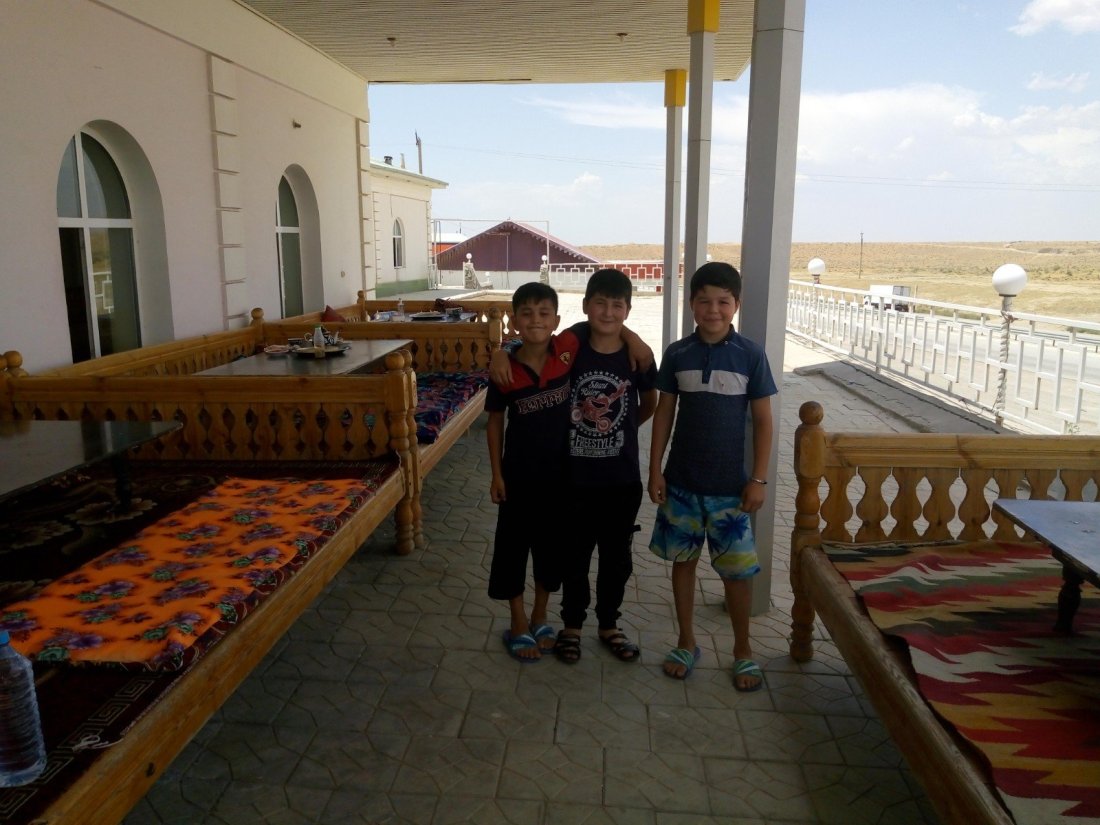
The road parallelled the river Amudarya, across which I could see into Turkmenistan.Over the last few years most Central Asian countries have been making things a lot easier for travellers. Turkmenistan is an exception. There is a choice between a ten day tourist visa, where one requires a full-time guide, or a five day transit visa often used by cyclists coming from Iran to Uzbekistan. Both options are expensive and not guaranteed, so I was not going to Turkmenistan just yet.

After a few more hours of cycling I set up camp, slept, and woke up the next morning ready to resume the ride. I was passed by a motorcycle at around midday, who turned out to be Adrian (the Romanian I’d met in Khiva). He thought I was mad to be cycling out here in this desert. “Well,” I said, “I’m sure people called you mad when you set off on this motorcycle trip?” “Yes,” he replied, “everyone does say that. But you really are mad!”
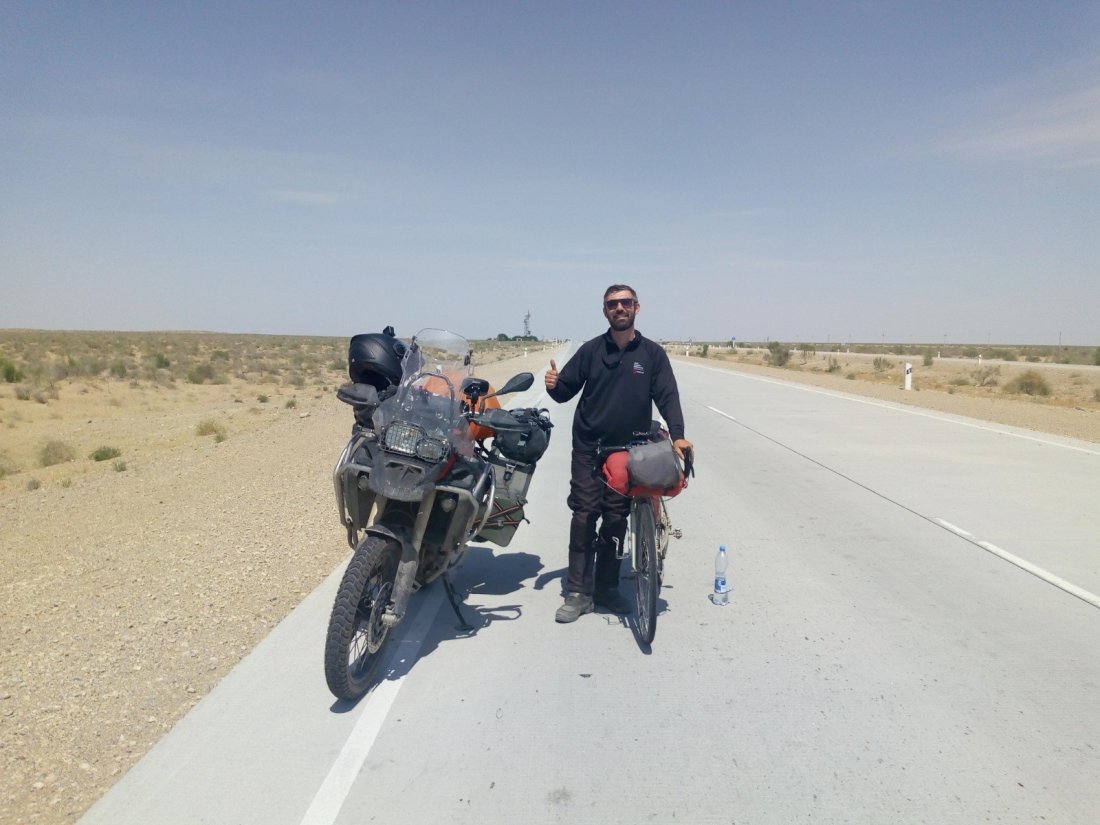
Despite my madness he kindly offered to pay for lunch for us both at a restaurant up ahead. After eating we continued riding – though he at a much faster pace!
I got a puncture not long after this, and found a rare patch of shade next to an abandoned building where I swapped out a new tube. The desert made for rather unexciting cycling, and the afternoon heat didn’t help. I decided to take a siesta. I stopped at a Chaikhana, bought a bottle of Pepsi, and lay down for a few hours.
The next morning I met a fellow traveller, Loretta. After a 5 year cycle tour she is now doing something different: walking/running while pulling a cart. We chatted for an hour or two at the side of the road before the swarm of flies got too bad and we both continued on.

I made my way into Bukhara, the second Silk Road city in Uzbekistan. I stopped at Rumi hostel and relaxed for the afternoon. In the evening I went out for dinner with Katajana from Poland and Ross from Scotland. In Uzbekistan shoes are left outside, and when I went to put mine on as we left the hostel there was a bit of toilet paper in them! I moved it aside before putting my shoes on.
When we returned to the hostel Ross noticed a van parked outside with GB plates. I recognised the van – it was, almost inevitably at this point, Emily and Doug! We went inside and I saw that another group of people from the Caspian ferry: Alex, Adele, Silvio and Binia. Apparently the toilet paper in my shoe had been a message – and they thought it was strange I hadn’t closely inspected it to read the note!

I spent an enjoyable evening hanging out and drinking with these guys before heading off to bed. The next morning was distinctly less enjoyable. It seemed I had contracted some sort of food poisoning. I moved to a private room as it seemed a little rude to permanently occupy the dormitory’s shared bathroom.
I’ll spare all the gory details but this day was particularly bad. I couldn’t keep any water down, got very dehydrated, and I think I even started to hallucinate a little. By afternoon my condition had improved to the point that I could at least keep water down but I still couldn’t stay very long outside the bathroom and had absolutely no appetite. This didn’t change much for the next few days. On the fourth day I decided to start taking imodium and rehydration salts. After that I began to gradually improve, to the extent that I was able to stay away from the bathroom for a couple hours at a time. By the fifth day I started eating again.
After a couple more days I felt well enough to go and spend a few hours wandering the city. Bukhara has historically been a more important city than Khiva and boasts an impressive and old collection of mosques and madrasahs.


T






The next day, I decided to leave Bukhara. I still wasn’t feeling great but I was pretty bored after over a week in one place. I set off early, managing to get out of the city before there was much traffic on the roads. Some local lads cycled with me for a bit and we chatted a little though with the language barrier there wasn’t much we could say.
I reached a bumpy section of road which really didn’t help my upset stomach. I was feeling rather nauseous as I bounced along this potholed and cracked road. I was very glad to return to a highway with its comparatively smooth surface.
As morning wore on it got hotter. Normally I’d stop to eat every 2-3 hours but I just couldn’t stomach any more than a few dry biscuits. Eventually at around midday I reached a shop and bought a lovely ice cold Fanta. I sat down in the shade right outside and, seeing this, the shopkeeper kindly bought me a mug to drink from and a cushion on which to sit. Another woman passing by offered me lunch but with my stomach as it was I had to decline. After a litre or so of Fanta I got back on the bike but didn’t cycle much further before deciding to stop at a hotel. I spent the afternoon there, managing to eat some crisps to replace the salt I’d lost through sweat.
My start the next morning was delayed slightly as I needed to get a registration slip. Officially, travellers in Uzbekistan are supposed to be registered every night, and receive papers which are checked on leaving the country. Less officially, the consensus seems to be that as long as you’ve got a few registration papers you should be ok. Most places were willing to fill in the form on the evening before I left, but this one insisted on waiting until morning and then took their time with it. I did eventually get the paper and set off cycling.
As before, I struggled from lack of appetite. The heat made my water taste rather unpleasant so I wasn’t drinking much of that either. My solution was to make frequent stops and buy cold Fanta wherever I could. This wouldn’t be a good long term solution but at least I was staying hydrated and getting some calories!
Later in the day I reached some rolling hills. These tired me right out and I was soon stopping even more frequently and for longer.

Finally I reached the city of Samarkand and, after one more break in a shaded park, I reached a hostel and checked in. Karl was already there, a cyclist I’d briefly met in Georgia and then again in Bukhara – though given my state at the time we hadn’t talked much. Adam and Tom, a pair of British cyclists arrived later in the day. They were followed the next day by Pierre and Victor, cyclists from France. It was nice to have lots of cyclists to chat to and I spent a few days in Samarkand, still gradually recovering from my illness.
I did eventually – after a couple of days – go and explore the city. Samarkand is Uzbekistan’s most famous cities. The Emir Timur (often called Tamerlane) made it the capital of an empire that stretched from Turkey to India. This spurred the building of many buildings – prominently Islamic centres of learning and mausoleums for Timur and his wife.




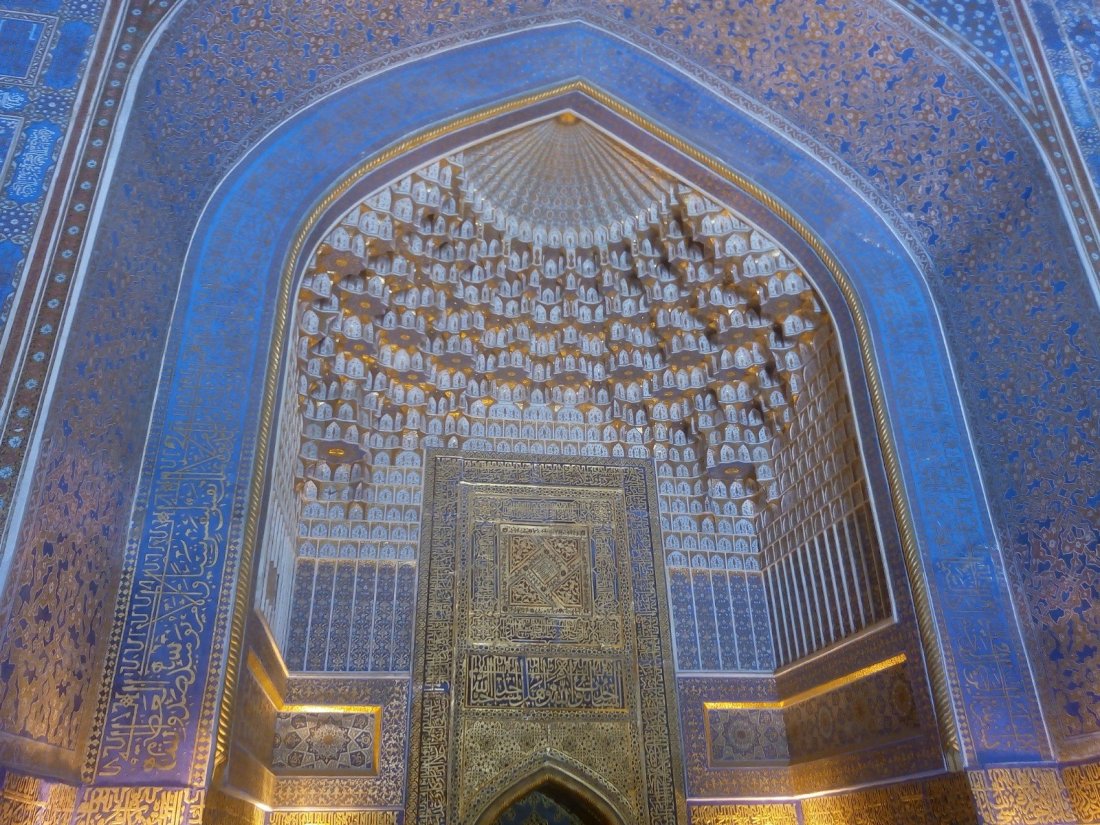






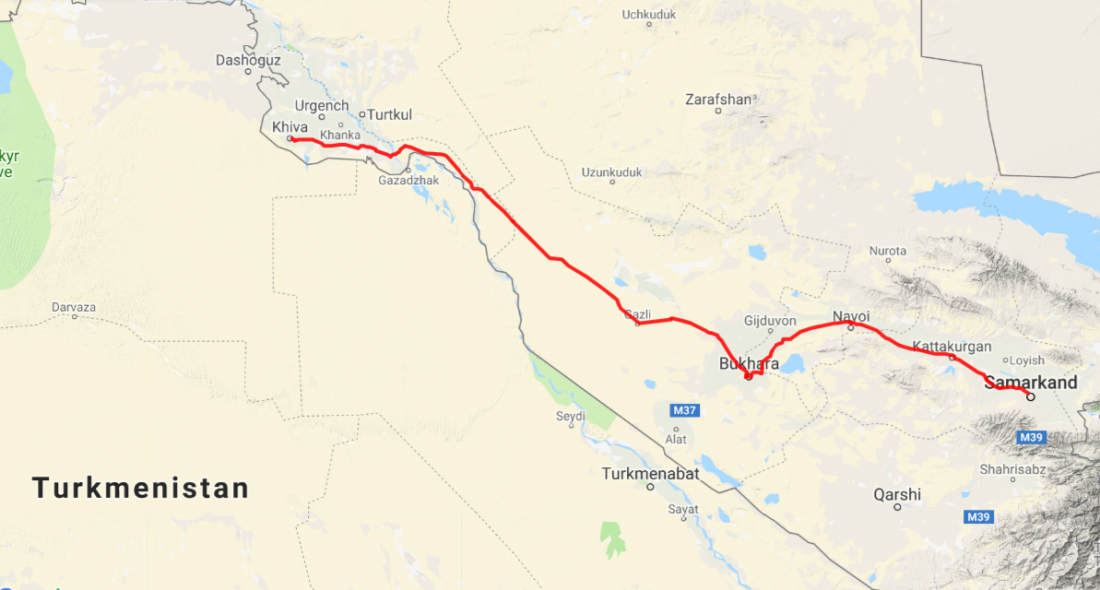
June 4: 200km
June 5: 151km
June 6: 79km
June 14: 106km
June 15: 154km
The tiles on the mosques are amazing!
LikeLike
Yeah, I really enjoyed the architecture in Uzbek cities. I usually prefer the countryside but in Uzbekistan the cities are definitely the main attraction.
Sam.
LikeLike